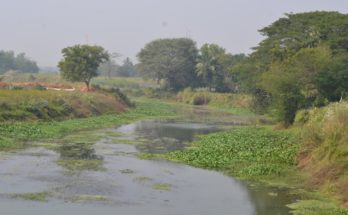Inscription is a short text engraved preferably on stone, terracotta, metal or even on wooden surface. It’s displayed near the monument or objects and has relation with it. Inscription serves as ready & valid data reference and supplies a great deal of information. And, epigraphy is the study of inscriptions.

There are some heritage sites with inscriptions in Bhubaneswar, but mostly restricted to temples. Hence, Udayagiri was deliberately chosen to go beyond temples & try with the murals & texts at caves which are much older than those found in temples. The twin hills of Khandagiri & Udayagiri were made in the 1st century BC during the reign of Samrat Kharabela. The caves, some naturally while mostly man-made, were used by the Jain monks for their dwelling & shelter during their travel. The twin hills originally had 117 caves, out of which only 33 are now accessible, 15 at Khandagiri & 18 at Udayagiri. The choice was obvious – both hills have inscriptions, but Udayagiri has more of it & the caves look more finished & better maintained. We have been a many times visited the twin hills, but mostly on random basis. Never thought of a walk with a specific plan & when the theme was coined by one of our enthusiastic heritage researcher, Ashish Sarangi, it immediately clicked. Once, the theme & site was freezed, the event was immediately posted in social media for the heritage lovers to turn up.

On the cool Sunday morning of 9th June, we gathered up at the entry gate of Udayagiri (meaning Sunrise Hills), which stands at the right side of the twin hills, at around 6.30 AM. By 6.45 we were in after collecting our respective entry tickets from the nearby ASI ticket counter. Without further delay, the walk was on starting with 8 walkers. There were mostly new faces when compared with the previous Sahasralinga walk, but all were quite known faces as heritage lovers like before, the theme was not disclosed till the last moment for obvious reason. We took the starting route from right side of entry gate passing through the Chota Hathi Gumpha & Baja Ghara Gumpha. Our first stop was the majestic two-storeyed Rani Gumpha caves. We enjoyed having a glimpse of the mural, beautiful toranas and sharing knowledge. Soon we were joined by two more walkers while we were moving towards the upper floor of Rani Gumpha where the life story of Samrat Kharabela was partially created in the cave corridor along with the hunting, battle & elephant clash scene with humans depicted. Thereafter we took a hairpin turn towards the elegant looking Ganesha Gumpha. We were quite delighted on catching a glimpse of the first inscription what we came across here. The inscription was in 5 lines in Brahmi script inside the Ganesha Gumpha.
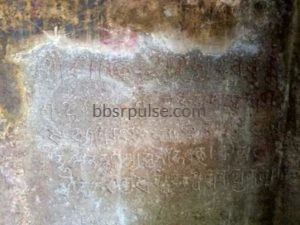
Thereafter, we moved on to the top of Udayagiri hills where one can view the growing Bhubaneswar city alongwith its busy airport. The top has an apsidal Chaitya in laterite, maybe used by the Buddhist Monks. The other side of the hill i.e Khandagiri hill with its set of caves & Digambar Jain Temple was looking lovely in the light foggy morning atmosphere from Udayagiri side. We descended downwards & on the way we came across Byaghra Gumpha (with one inscription) which looks quite different from the rest of caves for its mouth resembling a tiger’s mouth with a lizard mural inside. Upon reaching Jambeswar Gumpha, we were double delighted because we sighted one more inscription, adding the total to three. The inscription tells that it’s the cave of Nayaki/Nakiya, wife of Mahamade. Thereafter we passed through some gumphas on the right side including the Haridasa cave, which has inscription, before turning towards Sarpa Gumpha (with two inscriptions) which can be easily identified with the three headed snake mural on its top. Incidentally, the staircase & the minor caves adjacent to it is the ideal place for taking group image & we took no time to take our turn.
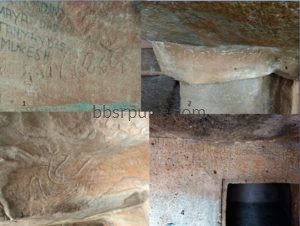
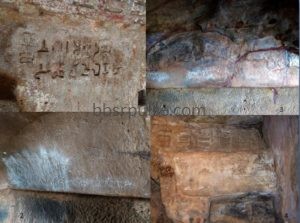
Finally, it was the turn for the naturally made Hathigumpha Cave (chiseling done inside), the best inscription cave at Udayagiri, hence reserved for the last lap of our walk. This cave is known for its majestic size like that of an elephant (the name hathi meaning elephant). But our interest was in observing the Kharabela & minor inscriptions, rock cut art & symbols there. The Hathigumpha inscription created by Kharavela is the only source of info on him. It’s the biggest inscription & a gem for epigraphy studies. There are altogether 17 lines I it mentioning his 13years of achievement, restoration work of fort, fatherhood, Bharatbarsha term used, attack on Magadha etc. The most unusual aspect is the direction of the inscription facing Dhauli. It’s said that Samrat Kharabela did it intentionally to avenge Kalinga’s defeat at the hands of Ashoka who had created the Dhauli edicts & Kharabela’s subsequent revenge on Magadha. Interestingly, Khandagiri & Udayagiri hills are higher in height than Dhauli & are mentioned as Kumari Parbata in the inscription. On both the sides of inscription there are certain symbols noticed, used as a mark of start & end of text. Originally, Hathigumpha was a prehistoric rock art shelter as noticed by the rock engravings & paintings on the ceiling. The Manchapuri & Swargapuri Gumphas were among the last set of caves we visited which has good reliefs on the cave walls. It has at least three inscriptions talking of one queen among the two and also about Kudepasiri, successor of Kharabela.
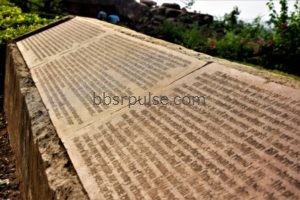
One question that always strike our mind is that how these caves with ornamentation were made at that time since certain murals & images were not finely made but roughly made with crude tools, like that of the two elephants at Ganesha Gumpha. And, most importantly how these caves were named. Whether it’s based on deciphered data by ASI or local names existing during the documentation or both. These caves are well maintained, yet it needs to be barricaded to save it from human intervention & vandalism. Some of the dwarapalas with armour are quite distinct from the rest. The barefooted ones with spear are said to be Indians while the others with gun boots & thick sword looks like that of foreign (Jabana) origin. Yet, we came across at least one third kind, which is a hybrid . Some symbols were noticed like swastika which is said to be the first ever instance of its usage in monument sites in India. Triratna is a quite interesting symbol which tells about the three right steps. The overall output of the trail was quite interesting & out of around 25 inscriptions, we could manage to see at least 15 which is quite good. Rest will be tracked down in near future.

Photos: Taranisen Pattnaik
©2012-2019 All Rights Reserved. Info@bbsrpulse.com



